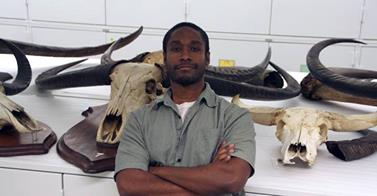Toward the end of my first semester as a PhD student in the HomPal program at GW I was invited to collaborate with my advisor and two of our post-docs on a project they’d developed. My role in this endeavor meant using familiar devices like calipers and an osteometric board to collect an immense dataset of all living ape genera, which gave me the exciting opportunity to visit skeletal collections at the American Museum of Natural History in NYC, Harvard’s Museum of Comparative Zoology in Boston, Cleveland’s Museum of Natural History in Ohio, and the Smithsonian Institution here in DC. Undergraduate course-level research projects aside, I’d never officially participated in research, and although I’ve had a fascination with species’ skeletal morphologies as long as I can remember I never had the opportunity to explore the variation within taxa so thoroughly. Being a part of this project and watching it develop has been a very rewarding part of the last year.
From roughly 9am-5pm for months, I was alone and 3 knuckles deep digging through what seemed like acres of towering cabinets, filled with more-or-less complete remains of humans, chimpanzees, gorillas, gibbons, and orangutans. Visiting cities and museums that I knew from childhood or had never visited, and meeting friendly collections managers, fellow researchers, and random locals were all experiences that formed lasting memories and helped me gain familiarity and perspective on life as a researcher, but really spending time with the collections—each specimen of which was an individual who had a dramatic life of its own—helped me to appreciate the types of variation that exist within species.
Although I was quickly recording measurements, I had plenty of opportunity to recognize the similarities of shape that characterized species, as well as the unique, sometimes exaggerated, anomalies that made each specimen an individual. I even took the occasional moment or two to scrutinize the remains of non-primate taxa kept at the collections. In all taxa it seemed that I was seeing undulating and amorphous morphological clouds rolling over and around a considerably more solid template.
At the end of each day, I had the reward of seeing a dataset that was growing and becoming more complex—inching ever closer to completion. And that was just the start of most days when collecting out-of-town: in the evenings I took every chance to explore what each city had to offer and attempted to get a sense of what life might be like as a local. I was also pleasantly surprised to find that many people are interested to hear about paleoanthropology and how we conduct our research. As each night ended I knew that I could look forward to doing the same thing the next day.
I finished my data collection in the Fall of 2013, and we’ve since analyzed the data and have been translating our results into a poster that I’ll present at the American Association of Physical Anthropologists meeting in Calgary, April 2014. Putting this poster together and giving a brief practice talk about it to faculty and students has been an experience all on its own, but I’m excited to talk about our results with the larger scientific community.
In the last year I’ve learned a lot about how research is conducted and coordinated, I’ve come to have a greater appreciation for the kinds of morphological complexity that have guided my interests in human evolutionary anatomy, and I have been preparing to present the results of our work to a greater audience. As someone who, in youth, once spent hours wandering museums wondering about the lives of the people who did all the discovering, I am proud to have joined their ranks, and I am looking forward to solidifying that position as my career develops.


